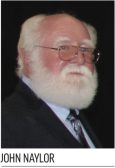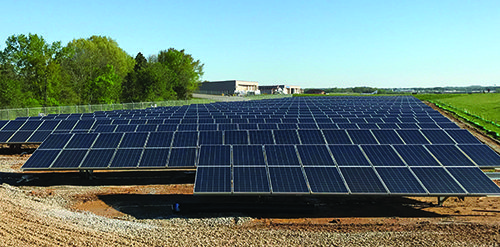Chattanooga Metropolitan (CHA) has managed to turn unused land alongside its runways and taxiways into an environmentally sound source of electricity that powers the same amount of energy that CHA facilities at the Tennessee airport use each year.
Chattanooga Metropolitan (CHA) has managed to turn unused land alongside its runways and taxiways into an environmentally sound source of electricity that powers the same amount of energy that CHA facilities at the Tennessee airport use each year.
 CHA’s $10.3 million solar photovoltaic farm is 2.74 megawatts (MW) in size and generates about 3,840,000 kilowatt hours per year—roughly the same amount consumed by its buildings, airfield lights and equipment. The airport sells power generated by the farm to its local utility provider, and then purchases electricity just like other customers.
CHA’s $10.3 million solar photovoltaic farm is 2.74 megawatts (MW) in size and generates about 3,840,000 kilowatt hours per year—roughly the same amount consumed by its buildings, airfield lights and equipment. The airport sells power generated by the farm to its local utility provider, and then purchases electricity just like other customers.
Last year, CHA spent $264,000 on electricity for its commercial service terminal; in 2017 it purchased $255,000 of power, reports Airport Planner Jack McAfee.The solar initiative has made an enormous dent in that cost. In 2017 and 2018, CHA earned $235,000 per year selling power from its farm. Revenue will undoubtedly be higher this year due to the recent addition of a third solar array. McAfee estimates it will add about $50,000 of revenue per year, bringing the farm’s annual earnings total up to $290,000—more than the CHA spent purchasing power last year.
|
Project: Solar Photovoltaic Power Farm Location: Chattanooga (TN) Metropolitan Airport Configuration: 3 ground-mounted arrays installed on airfield; all associated electricity is sold to local utility
Annual Output: 3.84 million kWh/year—roughly same amount consumed by airport-owned buildings, airfield Total Cost: $10.3 million Funding: $4.3 million VALE Grant; FAA Section 512 Energy Efficiency Grants of $3.4 million & $1.7 million; $940,000 from airport passenger facility charges Associated Revenue: Airport sold $235,000 of solar-generated electricity per year to local utility in 2017 & 2018. Income expected to increase this year, with recent addition of 3rd array Project Timeline: 2010-present Design/Installation: Inman Solar Panel Manufacturer: Suniva for Phases 1 & 2; Heliene Solar for Phase 3 Ongoing Operations & Maintenance: Inman Solar |
Thanks to federal grants, the airport’s out-of-pocket cost for the entire farm was less than $1 million. (See Facts & Figures section to the left for funding specifics.)
“We were the first airport in the nation to achieve the renewable energy goal of generating enough green power to match our energy usage,” reports John Naylor, the recently retired vice president of Airport Planning for the Chattanooga Metropolitan Airport Authority. “We produce the amount of power that we use.”
After expanding steadily over several years, CHA’s solar initiative currently includes three ground-mounted arrays. Located on the airfield, the solar farm is flanked by several airport buildings that have achieved high certifications for Leadership in Energy and Environmental Design (LEED).
“First and foremost, the Chattanooga Airport is here solely to support our community and customers,” emphasizes Naylor. “And one way we do that is by helping clean the air as providers of green power. Our move to produce renewable power started out about saving money. But it’s not only about money. It’s about serving our customers. In accomplishing the goal of reducing energy consumption and costs, the airport was able to hold down costs for the airlines, which ultimately brought more service to the community.”
Last year, the two-runway airport logged 504,000 enplanements and handled 9,500 tons of cargo.
Implementing Solar
CHA’s solar initiative began in 2010 with relatively small steps. The first phase, a 1 MW array with nearly 4,000 solar panels, started operating in 2011; and another installation followed two years later. The effort gained further momentum in 2017, when a conversion of the airfield and terminal lights to more efficient compact florescent and LED fixtures prompted a wider conversation about energy efficiency. Inman Solar designed and installed all three phases of the solar farm. The panels were manufactured by Suniva for Phases 1 and 2 and Heliene Solar for Phase 3.
In the early years, the airport worked with EPB, its local power utility, to identify grant opportunities for solar projects. Armed with that information, airport personnel developed a solar plan and presented it to the FAA.
Safety concerns regarding potential reflectivity problems left the agency decidedly unenthusiastic. Officials were particularly worried about glare into the control tower and aircraft cockpits. “They really pushed back on us during our first grant application,” Naylor recalls.
Mark Jones, a principal at Inman Solar, says complying with offset/elevation rules and conducting a glint and glare study are two important steps airports can take early in their project planning to address FAA’s key concerns.
 As for glint and glare, arrays must be located south of control towers to minimize the possibility of solar panels reflecting sunlight into a tower and compromising the vision of controllers inside.
As for glint and glare, arrays must be located south of control towers to minimize the possibility of solar panels reflecting sunlight into a tower and compromising the vision of controllers inside.
At CHA, Naylor conducted an airfield study that examined a number of factors. FAA’s CFR Part 77 emerged as a key issue. “Siting and reflectivity must be looked at carefully,” he emphasizes.
Part 77 rules require structures, including ground-mounted solar arrays, to be located at least 400 feet from runway centerlines, and at heights below a 7-to-1 slope beyond the 400-foot offset distance. To comply with these requirements, Inman technicians modified the original design configuration of CHA’s first array. Subsequent phases of the project required earthmoving crews to change the elevation of nearby sites for the next two arrays—in one case lowering the elevation, and raising it in the other.
“The land areas in all three phases of the solar project could not have been used for a building or other structures due to the Part 77 offset rules,” Jones explains. “Using these areas for ground mounted solar arrays allowed the Chattanooga Airport to utilize what would have otherwise been unusable land.”
Naylor describes another challenging aspect of the process: “We also needed to study all of the environmental issues, which included a FEMA study. The site was in the flood plain and we had to have the site surveyed and a LOMA [letter of map amendment] filed and approved. Once all of that was completed, a 7460 was filed with the FAA to study if there were any NAVAID or airspace issues. Everything was approved, and the local FAA Systems Support Center (SSC) objected. Therefore, a second 7460 was filed and the FAA SSC objections were denied; and approval was granted.”
The end result: CHA officials identified usable land south of the tower for its renewable energy project.
 Jones reports that installing the structures was otherwise fairly routine. He notes that CHA’s grid-connected system sells all the power it produces to the local utility for subsequent distribution/sale—vs. a net metered system, which provides power directly to its owner/operator. Typically, facilities with net metered systems are still connected to the grid so they can receive electricity when the sun is not shining, he notes.
Jones reports that installing the structures was otherwise fairly routine. He notes that CHA’s grid-connected system sells all the power it produces to the local utility for subsequent distribution/sale—vs. a net metered system, which provides power directly to its owner/operator. Typically, facilities with net metered systems are still connected to the grid so they can receive electricity when the sun is not shining, he notes.
Financing airport solar farms is another matter. CHA received federal grants for each phase of its project: a $4.3 million FAA VALE (Voluntary Airport Low Emissions) Grant in 2011 for Phase I; a $3.4 million FAA Section 512 Energy Efficiency Grant in 2013 for Phase II; and a $1.7 million FAA Section 512 Energy Efficiency Grant in early 2019 for Phase III. CHA paid for its 10% share—$940,000—with passenger facility charges.
Integrating Solar
CHA’s solar farm is part of a larger environmental program that has made the airport greener and more energy-efficient. While Inman crews installed the three arrays, CHA was also executing other sustainability projects.
When the first solar array began producing power in 2011, the airport debuted its LEED Platinum general aviation terminal and a LEED Gold hangar. In 2013, during the second phase of the solar project, another LEED Gold hangar and office complex was completed.
More projects followed in short order. In 2014, the commercial service terminal was renovated and certified as LEED Silver; and in 2016, a third LEED Gold hangar opened at CHA.
“Involve your power companies and FAA Airports District Office from the start,” advises Naylor. “You will be a team.”
Jones also encourages airports to contact their local electric providers, noting that rules and regulations regarding solar power vary from state to state.
Interest from within the industry seems to run high. Throughout the years, personnel from about 50 airports have contacted CHA with questions about the costs and benefits of its solar farm.
Naylor suggests starting out small: taking steps to reduce energy consumption, and then reinvesting those savings into larger projects. “Do your homework, as solar is not the answer for every airport,” he cautions, noting that some will simply not have the right land or site available to comply with FAA safety regulations.

What’s Next?
CHA officials are not resting on their laurels. Beyond more solar panels, a number of other sustainability projects are also in the works.
“Moving forward, we will continue to set energy goals to reduce our carbon footprint,” remarks McAfee. “As we remove older, inefficient buildings, they will be replaced with modern, LEED-certified buildings that are energy-efficient.”
In addition, the airport is continuing its ongoing conversion to electric ground support equipment with charging stations. Electric charging stations are also slated for vehicle parking lots.
“We should not remain satisfied having been an early integrator of solar,” says McAfee, “We want to continue to set an example for other airports to follow. The largest obstacle to overcome in the near future is convincing and educating others on the benefits of going green.
“I can’t predict the future any better than the next person,” he adds. “But as new green opportunities present themselves, we must be open to thinking outside the box.”
|
Other Airport Arrays Chattanooga Metropolitan (CHA) is in good company when it comes to U.S. airports harnessing solar power. A 2015 ACRP report by The National Academies of Sciences, Engineering and Medicine lists 70 such projects in 25 states and the Virgin Islands. The article, titled Renewable Energy as an Airport Revenue Source, notes that the projects vary in size, cost, output, installation strategy and ownership arrangements. According to the report, the largest U.S. installation is Indianapolis International’s 25 MW ground array. Other sizable farms include a 10.2 MW system built in installments at Denver International Airport from 2008 to 2014; and a 4.9 MW roof system at Phoenix Sky Harbor International Airport. Global standouts include the 40 MW solar farm that opened at India’s Cochin International Airport in 2015. A free PDF of the report is available at nap.edu/catalog/22139. ACRP also offers related publications, including Developing a Business Case for Renewable Energy at Airports and Guidebook for Developing a Comprehensive Renewable Resources Strategy. |


 facts&figures
facts&figures

